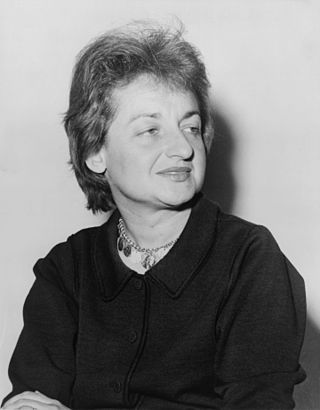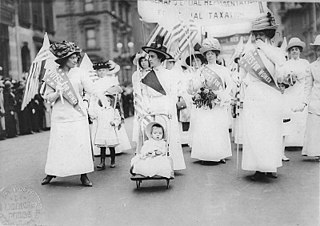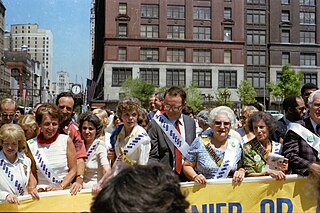
Betty Friedan was an American feminist writer and activist. A leading figure in the women's movement in the United States, her 1963 book The Feminine Mystique is often credited with sparking the second wave of American feminism in the 20th century. In 1966, Friedan co-founded and was elected the first president of the National Organization for Women (NOW), which aimed to bring women "into the mainstream of American society now [in] fully equal partnership with men.”
Liberal feminism, also called mainstream feminism, is a main branch of feminism defined by its focus on achieving gender equality through political and legal reform within the framework of liberal democracy and informed by a human rights perspective. It is often considered culturally progressive and economically center-right to center-left. As the oldest of the "Big Three" schools of feminist thought, liberal feminism has its roots in 19th century first-wave feminism seeking recognition of women as equal citizens, focusing particularly on women's suffrage and access to education, the effort associated with 19th century liberalism and progressivism. Liberal feminism "works within the structure of mainstream society to integrate women into that structure." Liberal feminism places great emphasis on the public world, especially laws, political institutions, education and working life, and considers the denial of equal legal and political rights as the main obstacle to equality. As such liberal feminists have worked to bring women into the political mainstream. Liberal feminism is inclusive and socially progressive, while broadly supporting existing institutions of power in liberal democratic societies, and is associated with centrism and reformism. Liberal feminism tends to be adopted by white middle-class women who do not disagree with the current social structure; Zhang and Rios found that liberal feminism with its focus on equality is viewed as the dominant and "default" form of feminism. Liberal feminism actively supports men's involvement in feminism and both women and men have always been active participants in the movement; progressive men had an important role alongside women in the struggle for equal political rights since the movement was launched in the 19th century.
Equality feminism is a subset of the overall feminism movement and more specifically of the liberal feminist tradition that focuses on the basic similarities between men and women, and whose ultimate goal is the equality of both genders in all domains. This includes economic and political equality, equal access within the workplace, freedom from oppressive gender stereotyping, and an androgynous worldview.
Second-wave feminism was a period of feminist activity that began in the early 1960s and lasted roughly two decades, ending with the feminist sex wars in the early 1980s and being replaced by third-wave feminism in the early 1990s. It occurred throughout the Western world and aimed to increase women's equality by building on the feminist gains of the late 19th and early 20th centuries.

The Feminine Mystique is a book by American author Betty Friedan, widely credited with sparking second-wave feminism in the United States. First published by W. W. Norton on February 19, 1963, The Feminine Mystique became a bestseller, initially selling over a million copies. Friedan used the book to challenge the widely shared belief that "fulfillment as a woman had only one definition for American women after 1949—the housewife-mother."
Lavender Menace was an informal group of lesbian radical feminists formed to protest the exclusion of lesbians and their issues from the feminist movement at the Second Congress to Unite Women in New York City on May 1, 1970. Members included Karla Jay, Martha Shelley, Rita Mae Brown, Lois Hart, Barbara Love, Ellen Shumsky, Artemis March, Cynthia Funk, Linda Rhodes, Arlene Kushner, Ellen Broidy, and Michela Griffo, and were mostly members of the Gay Liberation Front (GLF) and the National Organization for Women (NOW). They later became the Radicalesbians.
In one scholarly conception, the history of feminism in Poland can be divided into seven periods, beginning with 19th-century first-wave feminism. The first four early periods coincided with the foreign partitions of Poland, which resulted in an eclipse of a sovereign Poland for 123 years.

Veteran Feminists of America (VFA) is a 501(c)(3) charitable organization for supporters and veterans of the second-wave feminist movement. Founded by Jacqueline Ceballos in 1992, Veteran Feminists of America regularly hosts reunions for second-wave feminists and events honoring feminist leaders.

The National Organization for Women (NOW) is an American feminist organization. Founded in 1966, it is legally a 501(c)(4) social welfare organization. The organization consists of 550 chapters in all 50 U.S. states and in Washington, D.C. It is the largest feminist organization in the United States with around 500,000 members. NOW is regarded as one of the main liberal feminist organizations in the US, and primarily lobbies for gender equality within the existing political system. NOW campaigns for constitutional equality, economic justice, reproductive rights, LGBTQIA+ rights and racial justice, and against violence against women.
During the 1960s, the United States underwent a sexual revolution. The revolution was a social and cultural movement that resulted in liberalized attitudes toward sex and morality.Social norms were changing as sex became more widely discussed in society. Erotic media, such as films, magazines, and books, became more popular and gained widespread attention nationally. Sex was entering the public domain.

The Miss America protest was a demonstration held at the Miss America 1969 contest on September 7, 1968, attended by about 200 feminists and civil rights advocates. The feminist protest was organized by New York Radical Women and included putting symbolic feminine products into a "Freedom Trash Can" on the Atlantic City boardwalk, including bras, hairspray, makeup, girdles, corsets, false eyelashes, mops, and other items. The protesters also unfurled a large banner emblazoned with "Women's Liberation" inside the contest hall, drawing worldwide media attention to the Women's Liberation Movement.
Noreen Connell is an American feminist organizer and writer/editor, known for producing, with fellow New York Radical Feminists (NYRF) member Cassandra Wilson, the 1974 New American Library book Rape: A First Sourcebook for Women by New York Radical Feminists. She first joined the feminist movement through the August 26, 1970, New York City Women's Strike for Equality March and Rally and an autumn 1970 NYRF consciousness-raising group. After working as a NYRF conference and speak-out organizer and a founding member of the Women Office Workers in the early 1970s, Connell has chiefly served as an elected officer of women's rights advocacy groups such as the National Organization for Women (NOW).
Jacqueline "Jacqui" Michot Ceballos is an American feminist and activist. Ceballos is the former president of New York Chapter of the National Organization for Women and founder of the Veteran Feminists of America organization which documents the history of Second wave feminism and pioneer feminists. Ceballos' 1971 debate on sexual politics with Norman Mailer and Germaine Greer is recorded in the 1979 film Town Bloody Hall. Ceballos is also featured in the feminist history film She's Beautiful When She's Angry.

Feminism is aimed at defining, establishing, and defending a state of equal political, economic, cultural, and social rights for women. It has had a massive influence on American politics. Feminism in the United States is often divided chronologically into first-wave, second-wave, third-wave, and fourth-wave feminism.

The personal is political, also termed The private is political, is a political argument used as a rallying slogan of student activist movements and second-wave feminism from the late 1960s. In the context of the feminist movement of the 1960s and 1970s, it was a challenge to the nuclear family and family values. In 1970, the phrase was popularized by the publication of a 1969 essay by feminist activist Carol Hanisch under the title "The Personal Is Political". The phrase and idea has been repeatedly described as a defining characterization of second-wave feminism, radical feminism, women's studies, or feminism in general. It has also been used by some women artists as the underlying philosophy for their art practice.

The feminist movement, also known as the women's movement, refers to a series of social movements and political campaigns for radical and liberal reforms on women's issues created by inequality between men and women. Such issues are women's liberation, reproductive rights, domestic violence, maternity leave, equal pay, women's suffrage, sexual harassment, and sexual violence. The movement's priorities have expanded since its beginning in the 1800s, and vary among nations and communities. Priorities range from opposition to female genital mutilation in one country, to opposition to the glass ceiling in another.
This is a timeline of feminism in the United States. It contains feminist and antifeminist events. It should contain events within the ideologies and philosophies of feminism and antifeminism. It should, however, not contain material about changes in women's legal rights: for that, see Timeline of women's legal rights in the United States , or, if it concerns the right to vote, to Timeline of women's suffrage in the United States.
The following is a timeline of the history of feminism.
This is a Timeline of second-wave feminism, from its beginning in the mid-twentieth century, to the start of Third-wave feminism in the early 1990s.

The Women's liberation movement in North America was part of the feminist movement in the late 1960s and through the 1980s. Derived from the civil rights movement, student movement and anti-war movements, the Women's Liberation Movement took rhetoric from the civil rights idea of liberating victims of discrimination from oppression. They were not interested in reforming existing social structures, but instead were focused on changing the perceptions of women's place in society and the family and women's autonomy. Rejecting hierarchical structure, most groups which formed operated as collectives where all women could participate equally. Typically, groups associated with the Women's Liberation Movement held consciousness-raising meetings where women could voice their concerns and experiences, learning to politicize their issues. To members of the WLM rejecting sexism was the most important objective in eliminating women's status as second-class citizens.









